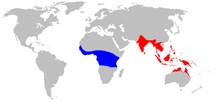User:Burklemore1/Sandbox 6
| Oecophylla Temporal range: Eocene - Recent
| |
|---|---|

| |
| Weaver ant (Oecophylla smaragdina) major worker (India). | |

| |
| Weaver ant (Oecophylla longinoda) major worker (Tanzania) | |
| Scientific classification | |
| Kingdom: | |
| Phylum: | |
| Class: | |
| Order: | |
| Family: | |
| Subfamily: | |
| Tribe: | Oecophyllini Emery, 1895
|
| Genus: | Oecophylla Smith, 1860
|
| Type species | |
| Formica virescens (junior synonym of Oecophylla smaragdina) | |
| Diversity[1] | |
| 2 extant species 13 extinct species | |

| |
| Oecophylla range map. Oecophylla longinoda in blue, Oecophylla smaragdina in red.[2] | |
Relationship with humans
In agriculture

Large colonies of Oecophylla weaver ants consume significant amounts of food, and workers continuously kill a variety of
Weaver ant husbandry is often practiced in Southeast Asia, where farmers provide shelter, food and construct ropes between trees populated with weaver ants in order to protect their colonies from potential competitors.[11]
Oecophylla colonies may not be entirely beneficial to the host plants. Studies indicate that the presence of Oecophylla colonies may also have negative effects on the performance of host plants by reducing fruit removal by mammals and birds and therefore reducing seed dispersal and by lowering the flower-visiting rate of flying insects including pollinators.[12][13] Weaver ants also have an adverse effect on tree productivity by protecting sap feeding insects such as scale insects and leafhoppers from which they collect honeydew.[13][14] By protecting these insects from predators they increase their population and increase the damage they cause to trees.[15]
As food and medicine
Weaver ants are one of the most valued types of insects eaten by humans (entomophagy). In addition to being used as a biological control agent to increase plant production, weaver ants can be utilized directly as a protein and food source since the ants (especially the ant larvae) are edible for humans and high in protein and fatty acids.[16] In some countries the weaver ant is a highly prized delicacy harvested in vast amounts and in this way contributing to local socioeconomics.[17] In Northeastern Thailand the price of weaver ant larvae is twice the price of good quality beef and in a single Thai province ant larvae worth 620.000 USD are harvested every year.[18][19] It has furthermore been shown that the harvest of weaver ants can be maintained while at the same time using the ants for biocontrol of pest insects in tropical plantations, since the queen larvae and pupae that are the primary target of harvest, are not vital for colony survival.[20]
The larvae of weaver ants are also collected commercially as an expensive feed for insect eating birds in Indonesia and the worker ants are used in traditional medicine in e.g. India and China.[21][22]
References
- ^ Bolton, B. (2015). "Oecophylla". AntCat. Retrieved 30 January 2015.
- .
- .
- ^ Chen, S. (1991). "The oldest practice of biological control: The cultural and efficacy of Oecophylla smaragdina Fabr in orange orchards". Acta Entomologica Sinica. 11: 401–407.
- .
- .
- ^ Van Mele, P., Cuc, N.T.T. & Van Huis, A. Direct and indirect influences of the weaver ant Oecophylla smaragdina on citrus farmers' pest perceptions and management practices in the Mekong Delta, Vietnam. International Journal of Pest Management 48:225-232.
- ^ a b Peng, R. & Christian, K. 2007. The effect of the weaver ant, Oecophylla smaragdina (Hymenoptera: Formicidae), on the mango seed weevil, Sternochetus mangiferae (Coleoptera: Curculionidae), in mango orchards in the Northern Territory of Australia. International Journal of Pest Management 53:15-24.
- ^ Peng, R.K & Christian, K. 2008. The dimpling bug, Campylomma austrina Malipatil (Hemiptera : Miridae): the damage and its relationship with ants in mango orchards in the Northern Territory of Australia. International Journal of Pest Management 54:173-179.
- ^ Offenberg, J. 2015. Ants as tools in sustainable agriculture. Journal of Applied Ecology. Early view. doi: 10.1111/1365-2664.12496. http://onlinelibrary.wiley.com/doi/10.1111/1365-2664.12496/abstract
- ^ Van Mele, P.; Vayssières, J.F. (2007). "Weaver ants help farmers to capture organic markets" (PDF). Pesticides News. 75: 9–11.
- doi:10.2307/2388425.
- ^ doi:10.1111/j.1440-1703.2004.00682.x.)
{{cite journal}}: Cite uses deprecated parameter|authors=(help - doi:10.2307/1932624.
- ^ Blüthgen, N. Fiedler, K., 2002 Interactions between weaver ants Oecophylla smaragdina, homopterans, trees and lianas in an Australian rain forest canopy. Journal of Animal Ecology, 71:5
- ^ Raksakantong P, Meeso N, Kubola J and Siriamornpun S, 2010. Fatty acids and proximate composition of eight Thai edible terricolous insects. Food Research International 43(1): 350-355
- )
- ^ Sribandit W, Wiwatwitaya D, Suksard S and Offenberg J, 2008. The importance of weaver ant (Oecophylla smaragdina Fabricius) harvest to a local community in Northeastern Thailand. Asian Myrmecology 2: 129-138. http://www.asian-myrmecology.org/publications/sribandit-et-al-am-2008.pdf
- ^ Offenberg J, 2011. Oecophylla smaragdina food conversion efficiency: prospects for ant farming. Journal of Applied Entomology 135(8): 575-581
- ^ Offenberg J and Wiwatwitaya D, 2010. Sustainable weaver ant (Oecophylla smaragdina) farming: harvest yields and effects on worker ant density. Asian Myrmecology 3: 55-62. http://www.asian-myrmecology.org/publications/offenberg-wiwatwitaya-am-2010.pdf
- ^ Césard N, 2004. Harvesting and commercialisation of kroto (Oecophylla smaragdina) in the Malingpeng area, West Java, Indonesia. In: Forest products, livelihoods and conservation. Case studies of non-timber product systems (Kusters K, Belcher B, eds), Center for International Forestry Research, Bogor, 61-77
- ^ Rastogi N, 2011. Provisioning services from ants: food and pharmaceuticals. Asian Myrmecology 4: 103-120. http://www.asian-myrmecology.org/publications/am04_103-120_ragosti_2011.pdf
